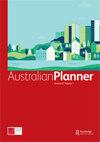Post-political planning in Sydney: a turn in the wrong direction
IF 1.2
Q2 Social Sciences
引用次数: 4
Abstract
ABSTRACT The New South Wales (NSW) Environmental Planning and Assessment Act (EPAA) was promulgated in 1979 to simplify the planning process, to pay particular attention to ecological sustainability and to improve community consultation in planning matters. In the four decades since its inception, the EPAA has been amended more than 150 times. The changes to the planning system have mostly revolved around the decision-making process, the unmistakeable struggle for control between the State and Local Government and the attempts to shift to a post-political/ managerial planning system. The delegation of substantial decision-making powers to Local Government by the EPAA on its inception forced the State Government to work collaboratively with Local Government. In practice, however, this has proven difficult for the NSW State Government. In this paper, we will draw attention to some of the decision-making reforms that have dominated the planning system debate in NSW, how they have created legitimacy questions and stronger opposition to planning decisions, and how a shift to a post-political decision-making system is being used to overcome the power and legitimacy of collaborative planning and to re-concentrate the decision-making powers in the political hierarchies. We conclude that the change to the post-political system of the past decade is a move in the wrong direction. The most recent amendment to the EPAA regarding the compulsory use of the Independent Hearing and Assessment Panels (IHAP) in all Sydney metropolitan councils, hides political influences within the decision-making process and is another means of eliminating or undermining the democratic scrutiny that comes with the exercise of political powers. These changes with time could create a risk to the integrity of the profession.悉尼的后政治规划:一个错误方向的转折
新南威尔士州(NSW)环境规划和评估法案(EPAA)于1979年颁布,旨在简化规划过程,特别关注生态可持续性,并改善规划事项中的社区咨询。《环境保护法》自制定以来的40年里,修改了150多次。规划制度的变化主要是围绕决策过程、国家和地方政府之间明显的控制权斗争以及转向后政治/管理规划制度的尝试。环保局一开始就将重要的决策权委托给地方政府,这迫使州政府与地方政府合作。然而,在实践中,这对新南威尔士州政府来说是困难的。在本文中,我们将关注新南威尔士州主导规划系统辩论的一些决策改革,它们如何产生合法性问题和对规划决策的更强烈反对,以及如何利用向后政治决策系统的转变来克服协作规划的权力和合法性,并将决策权重新集中在政治阶层中。我们的结论是,过去十年对后政治体制的改变是朝着错误的方向迈出的一步。最近对《环境保护法》进行的关于在悉尼市议会中强制使用独立听证和评估小组的修正案,隐藏了决策过程中的政治影响,是消除或破坏行使政治权力所带来的民主审查的另一种手段。随着时间的推移,这些变化可能会对该行业的诚信构成威胁。
本文章由计算机程序翻译,如有差异,请以英文原文为准。
求助全文
约1分钟内获得全文
求助全文

 求助内容:
求助内容: 应助结果提醒方式:
应助结果提醒方式:


